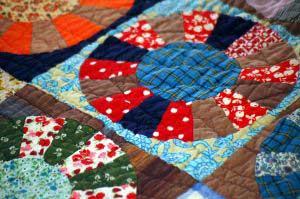 In Kelly’s recent post Tools To Use: Batting, she outlined several organic and sustainable choices for quilt batting – including my favorite, Hobbs Heirloom Organic Cotton Batting. Kelly was curious, though, about re-using old blankets or sheets instead.
In Kelly’s recent post Tools To Use: Batting, she outlined several organic and sustainable choices for quilt batting – including my favorite, Hobbs Heirloom Organic Cotton Batting. Kelly was curious, though, about re-using old blankets or sheets instead.
Being creative with your quilt ingredients is part of the history of quilting. Now granted, many of the choices that early quilters made were due to economic constraints. I suspect that if the pioneers had sewing machines and fabric shops readily and affordably available, a lot of them would have taken advantage of those options. However, quilting does have a historical ethic of conservation and re-use. Quilters today manifest this ethic through the obsessive saving of fabric scraps too small for any reasonable project, “just in case.”
So if you’re willing to look past batting, there are other earth-friendly alternatives for your quilt’s insides. Your linen closet, thrift stores, or donations from other people’s sewing supplies may provide just what you need.
When you’re making a heavy quilt, such as a denim quilt or a flannel rag quilt, you may not want to add the weight and warmth of batting to your project. A flannel sheet is a good alternative. You can also use a flannel sheet for the batting of a traditional quilt, but check first to make sure the pattern doesn’t show through the top or backing. For an even lighter weight, you can use a regular sheet. Regular sheets will give the quilt less body than flannel.
If you’re going to tie your quilt, regular or flannel sheets might be a great choice because they remove concerns about batting shifting over time. If you’re quilting, sheets will give you a very flat look for the finished quilt relative to batting, and the quilting stitches will be quite visible. You can also get away with less quilting.
For wall hangings, felt can be a good choice because of its stiffness. I’ve received leftover felt from a couple of people once they moved past making Halloween costumes for their children. I’ve been using it to practice free-motion quilting, but I could even re-use those pieces as the middle layers of small quilts. Like sheets, felt won’t have the same crinkly outcome as batting after washing.
You can even use an old, somewhat worn-out quilt as batting for your quilt. I know it may seem like heresy, but there are older quilts out there that are ugly and have no historical value. Caryl Bryer Fallert’s first quilt used a quilt as batting, and she says in the description that she’s pretty sure the batting in that quilt was worn-out long underwear. If you’re going to use an old quilt, make sure the batting of that quilt is in good condition. A quilt I recently inherited had batting that had turned into lumps and pellets. Not a good choice for your next project.
(You can take this idea one step further and use a lame, boring, mass-produced quilt picked up at a thrift store as the batting for your lovely, interesting, handmade quilt. Take that, Tommy Hilfiger!)
Other possibilities include light fleece blankets, or any other large piece of fabric with a weight that you think would work for your quilt. The two risks you run are uneven shrinkage and bearding (when the batting fibers “leak” through to the outside of the quilt, as can happen with polyester batting), so pre-wash your fabric in hot or warm water before using it and inspect it carefully for signs of fuzziness.
Finally, if you’re going to do fairly dense quilting, you can always piece together leftover batting scraps from previous projects. My good friend Stephannie of Silana Stitchworks gave me the following advice:
I just make sure that I quilt it densely enough that that section won’t shift around. I zig-zag stitch (widest I can manage) with the two pieces butting up right next to each-other – but not overlapping, since that would create bulk. I use a similarly colored thread. It’s amazingly easy to do, and really doesn’t take much time or patience. And it soothes me not to have to buy more batting when in total I have enough. I’ve successfully pieced like 5-6 little pieces together to make something large enough for the whole quilt. Sometimes the pieces all go in one direction, and sometimes it’s more of a puzzle piece sort of thing.
I’ve done this for a wall hanging, but now I think I’ll try it for a larger quilt and see how it goes.
Related Posts About Blankets and Quilting
- Winter Woolies
- Are The Amish Extreme Green Quilters?
- Top 5 Quilting Ideas for “Use What You Have” Month
[Photograph by Jonathan M.]


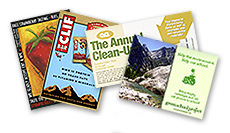

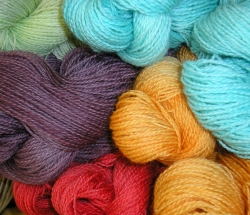

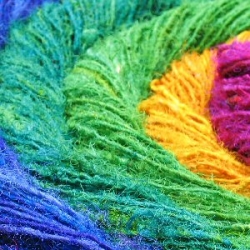


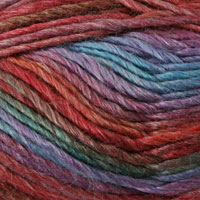
I have pieced together batting for use. I recommend not piecing these on a straight line. Rather, I would do a wavy line, but with the zig zag stitch and butted together as you describe. I find there is less movement this way. And I wouldn’t risk a pieced batt on a quilt that is likely to get washed a lot (like a baby quilt).
I have pieced together batting for use. I recommend not piecing these on a straight line. Rather, I would do a wavy line, but with the zig zag stitch and butted together as you describe. I find there is less movement this way. And I wouldn’t risk a pieced batt on a quilt that is likely to get washed a lot (like a baby quilt).
I have pieced together batting for use. I recommend not piecing these on a straight line. Rather, I would do a wavy line, but with the zig zag stitch and butted together as you describe. I find there is less movement this way. And I wouldn’t risk a pieced batt on a quilt that is likely to get washed a lot (like a baby quilt).
Great suggestions! I’m a beginning quilter but an experienced seamstress and appreciate the ideas for saving money by reusing things we already have like sheets. Thank you!!
Great suggestions! I’m a beginning quilter but an experienced seamstress and appreciate the ideas for saving money by reusing things we already have like sheets. Thank you!!
Great suggestions! I’m a beginning quilter but an experienced seamstress and appreciate the ideas for saving money by reusing things we already have like sheets. Thank you!!
Great post!!!! Most people don’t take the time to think outside the box. Back in the day before there were fabric stores and the internet people used what they could get their hands on to create a blanket or quilt including feedsacks, saddle material, barn hay. Everything had a use, nothing was wasted. We have the luxury of living in a time when creativity can drive the train, not necessity.
You could use fleece as an alternative to batting. https://sewingsociety.com/this-secret-quilt-batting-alternative-is-saving-quilters-big-money/
As flannel offcuts can be used for quilting ,can I use it for making tortilla warmers
Fleece is not very environmentally friendly
I have over bought some curtain fabric so im going to wash it and piece together to use instead of batting . Will report later if it works ! Cannot see why not it cotton .